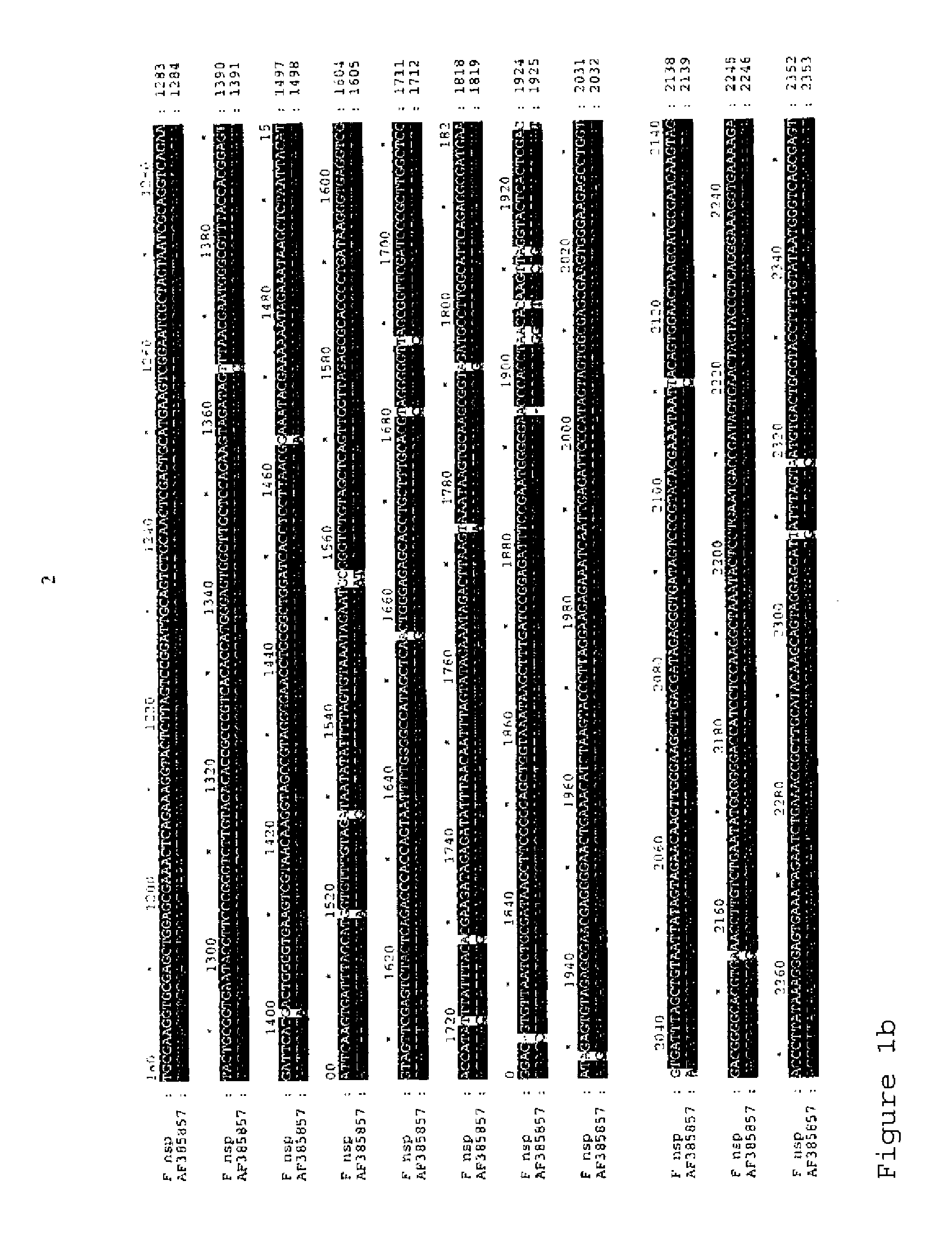Bacterium and vaccine
a gramnegative bacteria, pleiomorphic technology, applied in the direction of bacterial antigen ingredients, sugar derivatives, biochemistry apparatus and processes, etc., can solve the problems of high mortality during this stage of production, inability to adapt to all kinds of diseases, and infancy of cod farming
- Summary
- Abstract
- Description
- Claims
- Application Information
AI Technical Summary
Benefits of technology
Problems solved by technology
Method used
Image
Examples
example 1
Primary Isolation of the Organisms and Establishment of a Primary Isolation Medium
[0109]The novel bacterium according to the invention was isolated from the spleen of cod showing the clinical signs of the syndrome. This was done by bringing a sterile needle into the spleen, followed by taking some material from the spleen. This material was directly plated on an agar of 15° C.
[0110]It was found that the novel bacterium can be grown at temperatures between 10 and 15° C. on standard blood agar to which 0.1% cystein and 1% glucose are added. (This agar will also be referred to as Blood agar+cys+glu).
[0111]The novel bacterium according to the invention turned out to grow not only on a bacterial growth medium. Surprisingly it was found that intracellular growth of the bacterium is also possible. Suitable cells for growth of the bacterium are e.g. SHK-1 cells (head kidney cells from Atlantic salmon, Salmo salar), growing at the same temperature range. Growing SHK-1 cells has been describe...
example 2
Development of Cod's Syndrome, and Koch Postulates Test
[0113]In order to study the development of the disease, the onset of clinical signs of the novel bacteria was tested for both deliberately infected fish and fish cohabiting with other fish.
Bacterial Culture.
[0114]The novel bacterium was sub-cultured by spread plating onto Blood agar+cys+glu and incubated at 10° C. for 10 days. Subsequently the bacterial growth from all plates was combined and subsequently resuspended in 10 ml MEME (Minimal Essential Medium Eagle (Sigma)).
Fish
[0115]A total of 150 juvenile fish (juvenile cod =15-20 gram) were obtained from a hatchery where the novel bacterium has not been found. A number of fish from the same batch were tested by PCR (primers: FC-F2 (5′-ACAGGTCTTCGGATGCTGACG)[SEQ ID NO 8] and FC-R1 (5′-TCACTCCGTGGTAAACGCC)[SEQ ID NO 9] see below) of the internal organs (spleen and kidney) to confirm the absence of the pathogen. All fish analyzed were shown to be free of the pathogen.
[0116]The fish...
example 3
Further Challenge Experiments in Both Cod and Salmon
[0133]Challenge experiments were done on Atlantic salmon having an average weight of 40-50 g in fresh water and on Atlantic cod having an average weight of 20-30 g in seawater (3.5%) tanks at a water temperature of 12° C. The same batch of challenge inocula was used for both species. 20 fish were present in each group at the start of the experiment, i.e., 20 cod were injected intraperitoneally with SHK grown bacteria and only supernatant was injected (no cells), 20 were injected intraperitoneally with bacteria harvested from blood agar plates with additional cystein and resuspended in MEM (approx 109-1010 cells / ml->108-109 cells per fish). Additionally 20 non treated fish were added as cohabitants to investigate horizontal transmission. The experiments were terminated 19 days post challenge. FIGS. 6 and 7 show the time to onset of mortality and the cumulative mortality over time for Atlantic cod and Atlantic salmon respectively.
PUM
| Property | Measurement | Unit |
|---|---|---|
| Electrical conductance | aaaaa | aaaaa |
| Temperature | aaaaa | aaaaa |
| Temperature | aaaaa | aaaaa |
Abstract
Description
Claims
Application Information
 Login to View More
Login to View More - R&D
- Intellectual Property
- Life Sciences
- Materials
- Tech Scout
- Unparalleled Data Quality
- Higher Quality Content
- 60% Fewer Hallucinations
Browse by: Latest US Patents, China's latest patents, Technical Efficacy Thesaurus, Application Domain, Technology Topic, Popular Technical Reports.
© 2025 PatSnap. All rights reserved.Legal|Privacy policy|Modern Slavery Act Transparency Statement|Sitemap|About US| Contact US: help@patsnap.com



